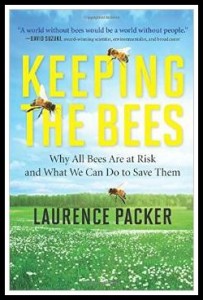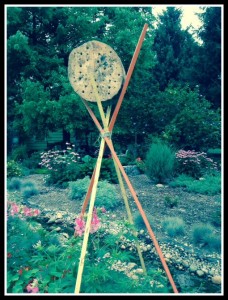The plight of the bees and other pollinators is frightening! Without bees, some say, humans would also cease to exist. A more likely scenario is that humans would live in a much less colorful and tasty world.
 I read a book recently titled Keeping the Bees: Why All Bees Are at Risk and What We Can Do to Save Them. It’s a great read, one I highly recommend. You will learn a lot about what is causing the bees’ distress and how much poorer our world would be without bees. You will also learn interesting facts about bee sex, bee predators, and more. It’s all astonishing and fascinating stuff!
I read a book recently titled Keeping the Bees: Why All Bees Are at Risk and What We Can Do to Save Them. It’s a great read, one I highly recommend. You will learn a lot about what is causing the bees’ distress and how much poorer our world would be without bees. You will also learn interesting facts about bee sex, bee predators, and more. It’s all astonishing and fascinating stuff!
The book’s author, Laurence Packer, earned a B.A. in zoology from the University of Oxford and a PhD from the University of Toronto. As well as being a professor of biology at York University, he is also a bee researcher and conservationist. He has a great knack for putting bee facts in human terms, such as when he notes that tracheal mites, bee parasites that are just one of the causes of bee decline, feel to the bee as it would feel to you to have cockroaches crawling around in your lungs! Unpleasant, to say the least.
The final chapter in the book lists six mostly cheap, easy things you can do to help the bees. Here is a summary:
- Grow bee-friendly plants, preferably native species. Showy blooms and prize roses may be beautiful, but they are not designed for bees. Says Packer, “It takes an unusually strong, pig-headed or desperate bee to get to them.” The answer is to plant a diverse array of simpler flowers, perhaps including clover in your lawn. The bees are hungry through spring, summer, and fall. Make the feast available!
- Provide nest sites for bees. This task can be as simple as keeping old raspberry and blackberry canes over the winter, using bamboo canes to stake your tomatoes, leaving alone any ground nests you find, cutting an edge around a flower or vegetable garden, and most surprisingly, skipping the mulch in spots. You can also build a bee hotel for solitary bees, as we did in Serendipity Gardens this summer. (See story below)
- Do not use pesticides. Pesticides kill the beneficial insects as well as the pests. More environmentally friendly ways to control pests include spraying an infusion of garlic on infested plants; squashing aphids, caterpillars or slugs between finger and thumb (if you can bear it!); or picking them off and drowning them in beer or diluted vinegar. You might even consider paying a local teenager to do the job for you!
- Buy organic food when possible. This was a new one for me because of the reason behind it. Do it, not for your own health, though that is also an excellent reason, but to encourage organic gardening. The more demand, the more supply and ultimately, the more affordability.
- Walk on the grass. Done frequently enough, walking on the grass instead of a designated pathway can create bare spots that the ground bees like for nesting.
- Encourage bee-friendly practices at various governmental levels. Encourage your city to seed roadside edges with native wildflower mixes. Support by-laws that promote pesticide-free gardening and bee-friendly urban planning practices,such as installing green roofs and adding natural areas to golf courses. Write letters to your Congressman about the need for national policies to protect pollinators.
A Simple Three-Step Recipe for Building a Bee House
Here at Serendipity Gardens, we built a bee house this summer. I was the impetus for the build, but my husband was the builder. Our process was rather simple.
 1. Get raw material. We have a neighbor down the road who sculpts animal figures from logs with a chain saw. To support his art, he keeps a regular supply of logs. My husband purchased two log slices, each seven inches long. Any source of wood would work so long as it is untreated. Seven inches is a minimum length, because you will want to drill the holes about four inches deep. The log must also be wide enough to accommodate several holes. These particular log slices are roughly 18 inches in diameter.
1. Get raw material. We have a neighbor down the road who sculpts animal figures from logs with a chain saw. To support his art, he keeps a regular supply of logs. My husband purchased two log slices, each seven inches long. Any source of wood would work so long as it is untreated. Seven inches is a minimum length, because you will want to drill the holes about four inches deep. The log must also be wide enough to accommodate several holes. These particular log slices are roughly 18 inches in diameter.
2. Using a carpenter’s pencil, mark a grid on the top surface of the log, with each line from 3/4 in to an inch apart. The intersections of these lines are where you will drill holes of various sizes.
Drill a selection of holes of varying diameters, no wider than 9/16 of an inch. Making holes any larger will result in holes too large for solitary bees to use. Our bee hotel has holes that are 3/16, 1/4, 5/16, 1/2, and 9/16 of an inch. Make sure the open ends of the holes are smooth with no splintered wood showing. If needed, use sandpaper or counter bore bits to remove splinters and smooth the entrance of each hole. After drilling each hole, carefully clean away any sawdust, as sawdust will discourage bees from entering the hole.
 3. Mount the hotel facing south or southeast, at least a meter high. Solitary bees are cold blooded and need direct heat from the sun to warm them in the morning. (Unlike bumblebees, they do not have any fur to help keep them warm.) Do not plant anything that will grow up to cover the hotel, and do not place it in the midst of existing vegetation that might cover the entry holes.
3. Mount the hotel facing south or southeast, at least a meter high. Solitary bees are cold blooded and need direct heat from the sun to warm them in the morning. (Unlike bumblebees, they do not have any fur to help keep them warm.) Do not plant anything that will grow up to cover the hotel, and do not place it in the midst of existing vegetation that might cover the entry holes.
We happened to have some unused poles tied together that were originally for beans to climb. This easy-to-make structure serves our purpose well. The bee hotel rests in the “arms” of the poles, and is tied to where they join for extra security. Now we will wait and see if any bees accept our hospitality. We hope a few move in!
If you want to build a bee hotel of your own, you will find numerous plans and methods online, on a site such as The Pollinator Garden.
The Serendipity Gardens crew also hopes that you will consider implementing one or more of the six bee-friendly practices Laurence Packer recommends.
Like this post? Sign up to receive an email each time a new post is available. We will never loan, sell or rent your email address — that’s a promise! Please use the buttons below to share with others.

I’m going to make one of these. It might keep them out of my wood siding.
Good idea!
I’m going to build one too. I love bees & want to keep them around for a long time to come.